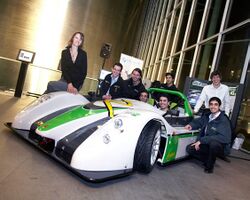Engineering:Racing Green Endurance
| SRZero | |
|---|---|
 | |
| Overview | |
| Manufacturer | Racing Green Endurance |
| Designer | Racing Green Endurance |
| Body and chassis | |
| Body style | 0-door roadster |
| Layout | Rear mid-engine, Rear-wheel drive |
| Platform | Unique, developed from SR8 Radical Sportscars |
| Powertrain | |
| Electric motor | two EVO Electric PM synchronous motors |
| Battery | 56 kW·h Li-ion battery |
| Range | 400 kilometres (250 mi) |
| Dimensions | |
| |uk|Kerb|Curb}} weight | 1,200 kg (2,600 lb) |
Racing Green Endurance (RGE) is a student-led project at Imperial College London to demonstrate the potential of zero emission cars. The team drove 26,000 km down the Pan-American Highway starting from north Alaska in July 2010, this was filmed by the documentary maker Claudio Von Planta.[1]
Motivation
Sustainability - Electric vehicles have the potential to realise a sustainable transport future, without depleting valuable resources for future generations. The RGE project aims to demonstrate this while pushing the boundaries of electric vehicle (EV) technology.
Education - The team want to help encourage the next generation of scientists and engineers through the outreach program. They plan to use the RGE project as an exhilarating example of where maths and science can take you.
Adventure - The Radical SRZero aims to be the world’s most focused, fun-to-drive alternative propulsion vehicle. By taking on this epic journey, they hope to add a sense of excitement and get people interested in electric vehicles.
RGE’s vehicle
RGE was sponsored an SR8 rolling chassis by Radical Sportscars to convert into a road legal electric sportscar. The electric SR8, dubbed the SRZero, was designed and built in just 7 months with components donated by many other companies.
On May 21, 2010, the car drove for the first time, but subsequent problems with electromagnetic interference (EMI) put the car back in the garage for several days work to rectify the problem. However, by the end of April the car had been successfully track tested up to a limited speed of 100 mph (160 km/h).
On April 29, 2010 the car passed the Individual Vehicle Assessment (IVA), and so is road legal in the UK and abroad. The SRZero now has the largest battery pack by energy storage out of any known road legalised vehicle in the UK.
The trip
In July 2010 the team took the 400 bhp SRZero all 26,000 km of the Pan-American Highway, educating and raising awareness along the way. Part of the mission is to dispel any worries about the range of electric cars. On the days of full driving the batteries will be drained 2/3, charged 1/3 and then depleted ready for an overnight charge. The journey lasted roughly three months, stopping at all major cities along the route to showcase the car and technology.
Public engagement
The public were encouraged to get involved wherever possible. Suggestions regarding places to visit on the trip, places to showcase the car, useful contacts, or even personal favours were all greatly appreciated via Twitter or email.
Origins
Racing Green Endurance was born as a spin-off from Imperial Racing Green in late 2008. Imperial Racing Green is an undergraduate teaching project to design and build fuel cell/electric hybrid racing cars, involving around 100 students from 8 departments within the university. The students are now designing and building the third generation of fuel cell powered racers.[2][3]
External links
- Racing Green Endurance Website
- RGE Facebook Page
- Imperial College Press Article
- Imperial Racing Green Website
References
- ↑ Interview with Claudio von Planta by Transport evolved
- ↑ Imperial Magazine monthly Podcast on Racing Green and Racing Green Endurance
- ↑ Transcript of Imperial Magazine monthly Podcast on Racing Green and Racing Green Endurance


